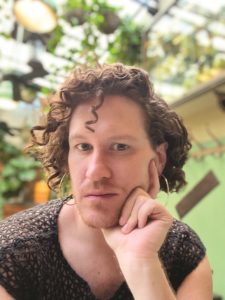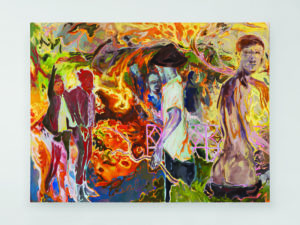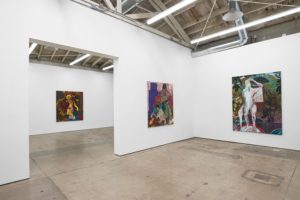Since arriving in Provincetown in October to begin a fellowship at the Fine Arts Work Center, Blake Daniels has spent “an unnerving amount of time just standing by the sea.”

Daniels, who grew up in Kentucky and Ohio and lived much of their adult life in Johannesburg, South Africa, isn’t used to a landscape defined by the omnipresence of water. “I’ve never lived by water in my life,” they said. “I don’t find peace in the ocean. I find it very unsettling.”
This may be why the artist’s tenuous relationship to new surroundings has managed to leak into Daniels’s new paintings on view at FAWC. “The underlying theme for the show is water,” Daniels says. “I’m uncomfortable in this landscape, and that has brought subtle things into the content, especially the presence of water in the work.”
The paintings depict close friends and lovers in a polychromatic dreamscape peppered with religious and mythical motifs. In one painting, a friend drags a skiff by rope across a waterless Johannesburg. (Daniels is considering calling it Sisyphus.) In another, two lovers embrace while being sundered by a writhing snake in a tableau that evokes Greek tragedy — specifically, Aeschylus’s The Libation Bearers.
All of Daniels’s subjects are intimate figures from their personal life — and most, if not all, are queer, though they are not marked as such by overt visual clues. Instead, Daniels prefers to forego scenes that are “politically marked” and “legible” to a wider audience for ones that they say “reckon with the complexities that exist in queer identities.”
Working from memory (rather than photographs), Daniels says, the paintings of bodies seek to “trigger the sensation I feel when I think about those people. It’s not about trying to capture reality in a sense of likeness. There’s something deeper.” The edges where bodies end and landscapes begin is not so clear. “A huge thing for me in my work is that landscape and figure often get blurry,” Daniels says. “It creates an obvious spiritual element.”
Daniels’s incorporation of mythical and spiritual realms into art reflects a deeply personal experience. “I grew up in a hyper-Christian family, a six-days-a-week church kind of family,” Daniels says. “It’s crazy when I think back to the things I believed when I was six or seven, like demons in the sky, horsemen, and the apocalypse. My inner world was wild. I was always fascinated by the lore. Going back to these things that oppressed me when I was a child, I now use them as a measure to tell my own tales and the tales of my communities.”

Instead of a place of security, home was a place that Daniels says “felt like it was collapsing in on me. Like a lot of other kids who grow up where their identities are being compressed, there was an impulse to flee.” They moved to attend an undergraduate program at the School of the Art Institute of Chicago, but Daniels “didn’t find the safe harbor I thought I was going to find.” They later enrolled in a master’s program at the University of the Witwatersrand in Johannesburg, where Daniels hoped “to fulfill my political, ideological duty. Also, because I was in love with someone.”
Though the relationship didn’t last much more than a year, Daniels’s love affair with Johannesburg endured. “In a weird way, I felt like a preteen when I moved there, because I went through my awakening of self in that space,” Daniels says. “It oriented me for the first time, and it gave me that safe harbor. It’s a city that may not be any more extraordinary than any other place, but to me it’s the most extraordinary place in the world.”
During Daniels’s time at Witwatersrand, student protests erupted across the nation in response to an increase in tuition fees. They became a wider movement that Daniels says was “about facing inequities remaining from apartheid inside the university system.” The protests turned violent as peaceful demonstrations were met with brutality from the police.

The political reality of South Africa forced them to “spend less time talking and more time learning,” Daniels says. “I saw a whole other system of racism, a racialized society that was different than America but one that carried a lot of the same violent earmarks. And I also came to recognize my own complacency within that.”
When the FAWC fellowship ends in April, Daniels will head to Paris to present new work at Galerie Julien Cadet. After that, they will be returning to Johannesburg, which Daniels describes as an “endless place of transformation and change” and a place where life and art coexist most comfortably.
“My chosen family doesn’t have a lot in common on the surface,” says Daniels. “We have different cultures, languages, religions, races, even gender and sexual identities. But we’ve woven these worlds together in our personal lives against all odds. I never want to paint the idea of a person. I want to make sure I’m painting the person in their complexity.”



